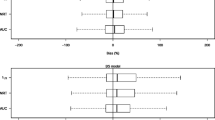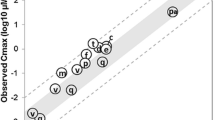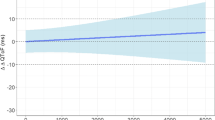Abstract
Aim
The investigations reported here aimed to evaluate the incremental benefit for dose finding by concentration-response analysis versus dose-response analysis.
Methods
Trials were simulated using an Emax model for a range of scenarios of drug properties, trial design options and target response levels. The simulated data were analysed by concentration-response and dose-response modelling; a dose was then chosen to target a specific response level in a confirmatory trial. The two approaches were compared in terms of the quality of model parameter estimation and the success rate for the confirmatory trial.
Results
While the accuracy for ED50 estimation was comparably good with both approaches, the precision was up to 90 % higher with concentration-response approach. The difference was most notable when clearance was highly variable between subjects and the top dose was relatively low. The higher precision by the concentration-response analysis lead to better dose selection and up to 20 % higher success rate for the subsequent confirmatory trial. The relatively small difference in success rate translated into a remarkable difference in sample size requirement.
Conclusion
By customising these parameters, the approach and the findings can be applied to assessing the value of pharmacokinetic sampling in particular trial situations.





Similar content being viewed by others
References
FDAMA (1997) Food and Drug Administration Modernization Act (FDAMA) (Pub.L.105–115)
Sheiner LB (1997) Learning versus confirming in clinical drug development. Clin Pharmacol Ther 1997(61):275–291
Bretz F, Hsu J, Pinheiro J, Liu Y (2008) Dose finding−a challenge in statistics. Biom J 50:480–504
Woodcock J, Woosley R (2008) The FDA critical path initiative and its influence on new drug development. Annu Rev Med 59:1–12
US FDA. Guidance for industry: exposure-response relationships — study design, data analysis, and regulatory applications [online]. Available from URL http://www.fda.gov/downloads/Drugs/GuidanceComplianceRegulatoryInformation/Guidances/ucm072109.pdf. [Accessed 2008 May 6]
European Medicines Agency. International Conference on harmonisation (ICH)E 4. Guidance on Dose–response Information to Support Drug Registration (CPMP/ICH/378/95)
Sheiner LB, Stanski DR, Vozeh S, Miller RD, Ham J (1979) Simultaneous modeling of pharmacokinetics and pharmacodynamics: application to d-tubocurarine. Clin Pharmacol Ther 25:358–371
Sharma A, Jusko WJ (1996) Characterization of four basic models of indirect pharmacodynamic responses. J Pharmacokinet Biopharm 24:611–635
Mager DE, Jusko WJ (2001) Pharmacodynamic modeling of time-dependent transduction systems. Clin Pharmacol Ther 70:210–216
Simeoni M, Magni P, Cammia C et al (2004) Predictive pharmacokinetic-pharmacodynamic modeling of tumor growth kinetics in xenograft models after administration of anticancer agents. Cancer Res 64:1094–1101
Lobo ED, Balthasar JP (2002) Pharmacodynamic modeling of chemotherapeutic effects: application of a transit compartment model to characterize methotrexate effects in vitro. AAPS PharmSci 4:E42
Jumbe NL, Xin Y, Leipold DD, Crocker L et al (2010) Modeling the efficacy of trastuzumab-DM1, an antibody drug conjugate, in mice. J Pharmacokinet Pharmacodyn 37:221–242
Lledó-García R, Hennig S, Karlsson MO (2009) Comparison of dose-finding designs for narrow therapeutic index drugs: concentration-controlled vs. dose-controlled trials. Clin Pharmacol Ther 86:62–69
Karlsson MO, Sheiner LB (1993) The importance of modelling interocasion variability in population pharmacokinetic analyses. J Pharmacokinet Biopharm 21(6):735–750
Karlsson MO, Beal SL, Sheiner LB (1995) Three new residual error models for population PK/PD. J Pharmacokinet Biopharm 23(6):651–672
Lockwood PA, Cook JA, Ewy WE, Mandema JW (2003) The use of clinical trial simulation to support dose selection: application to development of a new treatment for chronic neuropathic pain. Pharm Res 20(11):1752–1759
Lockwood P, Ewy W, Hermann D, Holford N (2006) Application of clinical trial simulation to compare roof-of-concept study designs for drugs with a slow onset of effect; an example in Alzheimer’s disease. Pharm Res 23:2050–2059
Dansirikul C, Silber HE, Karlsson MO (2008) Approaches to handling pharmacodynamic baseline responses. J Pharmacokinet Pharmacodyn 35(3):269–283
Chapel S, Kowalski K, Hutmacher M, Bockbrader H (2005) Pregabalin exposure-response analysis in patients with postherpetic neuralgia. Clin Pharmacol Ther 77:88–88
Pinheiro J, Hsu CH (2009) PAGE 18th Satellite meeting. Saint Petersburg
Acknowledgments
The authors thank Shuying Yang and Bruno Delafont for the discussion on the statistical summary of the simulated trial data.
Conflict of interest
The authors declare that they have no conflict of interest
Author information
Authors and Affiliations
Corresponding author
Rights and permissions
About this article
Cite this article
Berges, A., Chen, C. Dose finding by concentration-response versus dose-response: a simulation-based comparison. Eur J Clin Pharmacol 69, 1391–1399 (2013). https://doi.org/10.1007/s00228-013-1474-z
Received:
Accepted:
Published:
Issue Date:
DOI: https://doi.org/10.1007/s00228-013-1474-z




